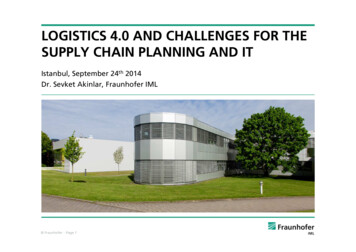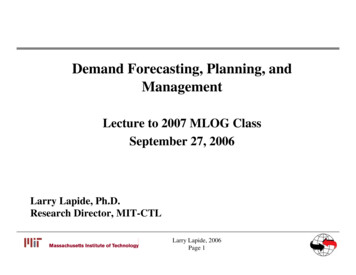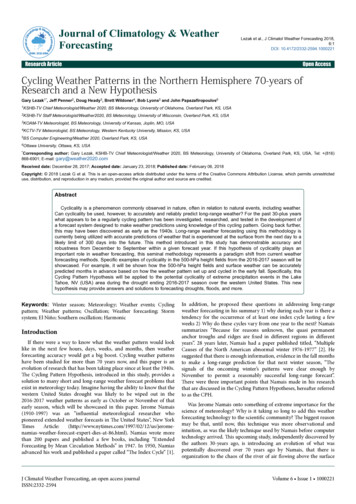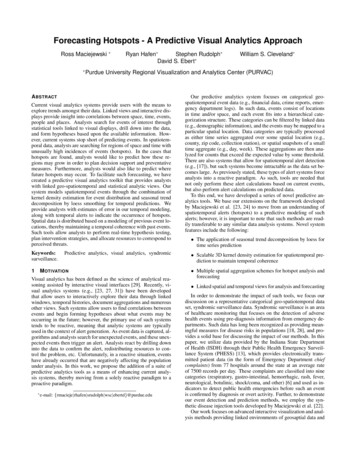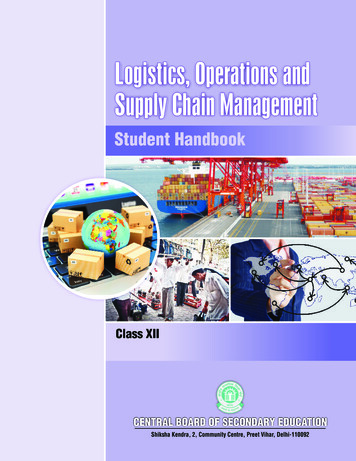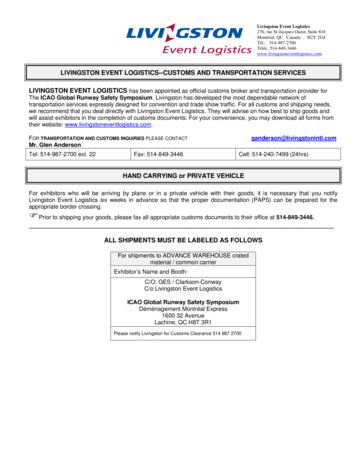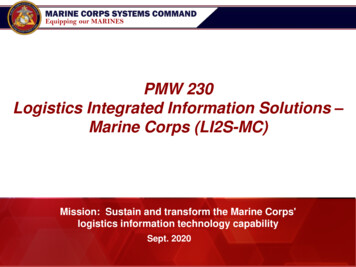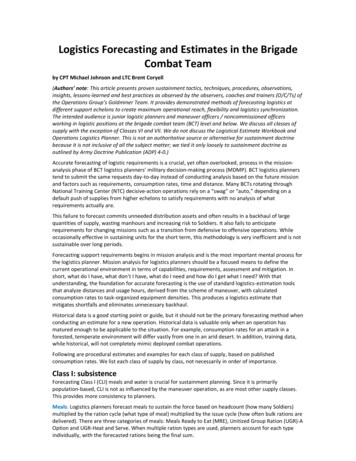
Transcription
Logistics Forecasting and Estimates in the BrigadeCombat Teamby CPT Michael Johnson and LTC Brent Coryell(Authors’ note: This article presents proven sustainment tactics, techniques, procedures, observations,insights, lessons-learned and best practices as observed by the observers, coaches and trainers (O/C/Ts) ofthe Operations Group’s Goldminer Team. It provides demonstrated methods of forecasting logistics atdifferent support echelons to create maximum operational reach, flexibility and logistics synchronization.The intended audience is junior logistic planners and maneuver officers / noncommissioned officersworking in logistic positions at the brigade combat team (BCT) level and below. We discuss all classes ofsupply with the exception of Classes VI and VII. We do not discuss the Logistical Estimate Workbook andOperations Logistics Planner. This is not an authoritative source or alternative for sustainment doctrinebecause it is not inclusive of all the subject matter; we tied it only loosely to sustainment doctrine asoutlined by Army Doctrine Publication (ADP) 4-0.)Accurate forecasting of logistic requirements is a crucial, yet often overlooked, process in the missionanalysis phase of BCT logistics planners’ military decision-making process (MDMP). BCT logistics plannerstend to submit the same requests day-to-day instead of conducting analysis based on the future missionand factors such as requirements, consumption rates, time and distance. Many BCTs rotating throughNational Training Center (NTC) decisive-action operations rely on a “swag” or “auto,” depending on adefault push of supplies from higher echelons to satisfy requirements with no analysis of whatrequirements actually are.This failure to forecast commits unneeded distribution assets and often results in a backhaul of largequantities of supply, wasting manhours and increasing risk to Soldiers. It also fails to anticipaterequirements for changing missions such as a transition from defensive to offensive operations. Whileoccasionally effective in sustaining units for the short term, this methodology is very inefficient and is notsustainable over long periods.Forecasting support requirements begins in mission analysis and is the most important mental process forthe logistics planner. Mission analysis for logistics planners should be a focused means to define thecurrent operational environment in terms of capabilities, requirements, assessment and mitigation. Inshort, what do I have, what don’t I have, what do I need and how do I get what I need? With thatunderstanding, the foundation for accurate forecasting is the use of standard logistics-estimation toolsthat analyze distances and usage hours, derived from the scheme of maneuver, with calculatedconsumption rates to task-organized equipment densities. This produces a logistics estimate thatmitigates shortfalls and eliminates unnecessary backhaul.Historical data is a good starting point or guide, but it should not be the primary forecasting method whenconducting an estimate for a new operation. Historical data is valuable only when an operation hasmatured enough to be applicable to the situation. For example, consumption rates for an attack in aforested, temperate environment will differ vastly from one in an arid desert. In addition, training data,while historical, will not completely mimic deployed combat operations.Following are procedural estimates and examples for each class of supply, based on publishedconsumption rates. We list each class of supply by class, not necessarily in order of importance.Class I: subsistenceForecasting Class I (CLI) meals and water is crucial for sustainment planning. Since it is primarilypopulation-based, CLI is not as influenced by the maneuver operation, as are most other supply classes.This provides more consistency to planners.Meals: Logistics planners forecast meals to sustain the force based on headcount (how many Soldiers)multiplied by the ration cycle (what type of meal) multiplied by the issue cycle (how often bulk rations aredelivered). There are three categories of meals: Meals Ready to Eat (MRE), Unitized Group Ration (UGR)-AOption and UGR-Heat and Serve. When multiple ration types are used, planners account for each typeindividually, with the forecasted rations being the final sum.
Meal example: If 100 Soldiers on an M-M-M ration cycle are issued a “2” cycle, the total MREs neededwould be 600 meals (100 headcount x 3 M per day x two days). Since meals are transported bycases/modules and pallets, the value would be converted using the charts shown. In the example, 600meals would equate to 50 cases, or one pallet of MREs plus two additional cases.Class I transportation planning factors for MREsRation packageWeightMeals per case12Cases/pallet48Weight/case22.7 poundsWeight/pallet1,089 poundsClass I transportation planning factors for UGRsRation packageWeightServings/module50Modules/pallet8 (400 servings)Weight/module128 poundsWeight/pallet1,020 poundsPallet size40 inches/48 inches/40 inchesTable 1. Class I MRE and UGR weight and pallet conversion.If conducting phased operations, the issue cycle could cover each phase, so a four-day phase would be anissue of “4,” pending unit haul and storage capabilities.Planners should adjust their total values to account for variances and unforeseen changes – for example,planners should add 10 percent to account for an unforeseen change such as an unexpected attachmentof a unit. More meals may be required for humanitarian aid, such as internally displaced personnel, andpersonnel holding, such as detainees and enemy prisoners of war.There are two primary considerations when transporting CLI meals: storing perishable items andtransporting cooked UGR meals. Units must consider the use of ice and Multi-Temperature RefrigeratedContainer Systems (MTRCSs) when incorporating perishable items into the ration cycle. Failure to do soresults in supplements being spoiled and wasted. Module 3 UGRs are the only meals that need coldstorage to remain safe to consume.Time is important when cooking UGR meals. Once heated to the correct temperature, there are only fourhours allotted to eat them. Therefore planners must be cognizant of where a unit’s assault/containerizedkitchen is located in relation to the forward troops. General planning factors are 20-35 minutesupload/download time (40-70 minutes), plus actual time traveled.Water: Categorize it into bulk, ice and decontamination planning when forecasting requirements. Bulk water. During Fiscal Year 2015, 59,800 gallons of bulk water were backhauled betweenforward-support companies (FSC) and brigade-support battalions (BSB) units at NTC, resulting inunneeded use of personnel and equipment. Bulk water planning follows the same MDMP interms of identifying capabilities, requirements and shortfalls. The brigade-support operationssection and brigade/battalion S-4s can calculate available water capabilities at echelon based onon-hand asset availability to understand the maximum water capability at each unit.Bulk water planning is similar to CLI meals in that you calculate it on a per-person, per-day cycle. Table 3of the Theater Sustainment Battle Book highlights planning factors with this methodology based on theclimate. Planners should use this in their initial analysis to forecast proper requirements. Adjust the waterconsumption requirements with historical data as the operation progresses.
Bulk water storage and requirementsModes of movement (capacity in gallons)Bulk fixed storage (capacity in gallons)BuffaloBlivotsHippoCamel3K SMFT5K 0050,000Table 2. Bulk water-storage capacity.UseTemperateTropicalAridArticDrinking water1.53.03.02.0Personal hygiene1.71.71.71.7Field feeding2.82.82.82.8Heat injurytreatment.1.2.2.1Vehicle maintenance----.2--Standard planningfactor6.17.77.96.6Table 3. Water-consumption factors in gallons/persons/day.Mortuary affairs operations are an additional planning factor considered at the BSB level. You need fourgallons per set of remains for processing. Ice. Forecast ice on a per-person, per-day basis based on the operational environment.Recommended planning factors in pounds per bag per person are Arid-6, Tropic-5, Temperate-4and Artic-3. The bag size determines how many bags per pallet (e.g., 103 20-pound bags fit onone wooden pallet). Use MTRCS for ice storage; 14 pallets fit into one MTRCS.Decontamination. Decontamination operations require substantial water requirements for eachcontaminated Soldier and vehicle. The unit decontamination crew conducts vehicle wash-downin the unit area of operations (AO). For operational decontamination, the vehicle wash-downcrew may use 100 to 150 gallons of hot, soapy water on each vehicle to wash off grosscontamination. For combat vehicles like the M1 series of armored fighting vehicles, 200 gallonsor more of water may be required per vehicle. Each 100 gallons of water provides a two- tothree-minute wash.1More gallons are required (see Table 4) for detailed equipment decontamination. For troopdecontamination beyond mission-oriented protective posture exchange, it takes 250 gallons of water per10 Soldiers or 25 gallons per person.2M12A1 PDDA rinseEquipmentM17 LSD rinseGallons appliedMinutes appliedGallons appliedMinutes appliedM1 tank325125714M2 BFV325125714M113 APC20393810M109A Paladin325125714HEMTT180830125-ton truck15874211Humvee904236Note: The rinse is done with the spray wand for the M17.Table 4. Detailed equipment decontamination planning factors for a rinse station.
Class II: clothing and equipmentRegular inventories conducted at unit supply level are the key to successful Class II (CLII) forecasting. Thisavoids a stock-out of critical office supplies, clothing and equipment. Soldiers deploy with an initial load ofclothing and equipment and are fielded theater-specific equipment during the unit’s reception, staging,onward movement and integration into theater. CLII is difficult to forecast in relation to phases of themaneuver operation because each echelon consumes supplies at a different rate. Planners should beaware of the need for CLII and work in close coordination with the BSB’s supply-support activity (SSA) todetermine transportation requirements CLII requests need.Class III petroleum, oil and lubricantsClass III (CLIII) can affect the success or failure of any unit conducting combat operations. CLIII iscategorized into bulk fuel (CLIII (B)) – including gasoline, diesel and aviation fuel – and packaged (CLIII (P))– including greases, oils and lubricants. Bulk CLIII. Bulk CLIII is complex to forecast due to the large variety of vehicle types, consumptionrates, varied terrain and hours of use. Determining bulk fuel-carrying capability is the same asbulk water: multiply available assets by their capacity amounts. Remember, though: never fillstorage assets to maximum capacity; consider expansion to avoid damage to personnel andequipment. Determining CLIII requirements requires detailed analysis of the maneuver conceptof the operation. Forecasters determine estimated fuel usage for each vehicle using the followingformula: number of vehicles x gallons per hour consumption x time in operation.CLIII bulk example: An armor company comprised of 14 M2 Bradley Fighting Vehicles (BFVs) is conductinga one-day operation on cross-country terrain. During a 24-hour period, the unit expects to be at a tacticalidle for 16 hours and traverse cross-country for eight hours. Expected fuel consumption at idle is 14 x 1.4 x16 314 gallons. Expected fuel consumption during cross-country operations is 14 x 18 x 8 2,016gallons. Total estimated fuel consumption for the operation is 2,330 gallons.Fuel planning factorsBulk lonblivotTPU pods7,4254,8002,250500500125125Bulk-fillrate (gpm)600300600300Self-loadrate (gpm)600300300300Retail flowper nozzle506050Number ofnozzles2222512Table 5. Bulk fuel-storage 4.6M2/31.418.08.6M1131.010.58.9M882.042.031.0M9 00
Table 6. Vehicle consumption rates in gallons per hour.Use this process for each vehicle type within a unit. While detailed, it provides an accurate estimate ofCLIII (B) consumption that helps identify and mitigate shortfalls to ensure operational success. As withother classes of supply, adjust amounts based on historical data and actual consumption.Calculate aviation fuel requirements the same as ground equipment. The number of aircraft multiplied byair hours allows planners to compute the estimated fuel needed.AircraftAH-64AAH-64DOH-58DCH-47DUH-60LMax speed(knots)170150120170193Cruise 0345/575300/500Passenger seatsN/AN/A13311Litter A317Table 7. Aviation planning factors. Packaged CLIII. Packaged CLIII forecasting requires coordination with supporting maintenanceelements. There is currently no single source manual for CLIII (P) requirements by vehicle type.Moreover, unit standard operating procedures (SOPs) usually do not address the CLIII (P) basicloads required by vehicle platform. Unfortunately, poor planning for packaged lubricants hasdetrimental effects. Commonly seen problems at NTC are engines low on oil or tracks that can’tbe adjusted due to the lack of “grease, artillery automotive.” Most units deploy with 15-30 daysof packaged lubricants on hand as part of their stockage listing. Environmental considerationssuch as dust, snow and rain affects the consumption rate of CLIII (P). Therefore, sustainers mustalso analyze transportation trends, regarding how long items take to arrive at the SSA to ensuretimely replenishment occurs.Class IV: construction materialClass IV (CLIV) planning is conducted when preparing for a phased defensive operation and for sustainedunit defense. Every echelon participates in materials planning and resourcing. Division echelonsdetermine each module configuration for their subordinate units. Each module will dictate the NationalStock Number, nomenclature, quantity and unit of issue for a given defensive combat-configured load(CCL). These modules are found in the division operations order’s Annex G (engineering), Appendix 3(general engineering), Tab C (engineer-specific CCLs).Logistics planners must coordinate closely with the brigade engineer planner to forecast CLIV at thebrigade-and-below level. The brigade engineer planner determines the number of CCLs based on thebrigade’s defensive operation. He or she tasks the number of modules needed for each battalion andwhere in the brigade’s AO to initially place the CCLs. The CCLs are built on container roll-in/roll-outplatforms or on flat racks using a brigade-tasked detail supervised by the brigade engineer battalion.Echelons-above-brigade units can build the CCLs if multiple brigades are operating within the same area.The BSB support operations officer coordinates transportation of CCLs to supported units based on thebrigade engineer planner’s tasking. Each CCL should arrive at the supporting FSC no later than 48 hoursbefore defensive operations start to give maneuver units time to establish and improve defensivepositions.
Aside from planning phased defensive operations, CLIV helps sustain unit defense for force protection.Unfortunately, units training at NTC consistently fail to plan adequate CLIV resources when building atriple-strand concertina wire defense. This happens because units lack understanding of CLIV resourcesneeded for defense.Planning for a sustained unit defense is a collaborative effort between the battalion executive officer andthe S-4 (logistics) officer when three primary defensive methods are integrated: The first method is the use of engineer assets to construct berms and hasty fighting positions.This is the preferred method due to the increased protection, lower use of unit resources anddecreased transportation assets. The second method is the construction of triple-strand concertina wire around the unit’sperimeter (Table 8). Planners should ensure they request adequate materials.3 The third method is a combination of the previous two that integrates each strength against theterrain arbedwire1NumberofGPBTONumber ofconcertinasStaplesManhoursto erect2Kg of materialsper linearmeter ofentanglement3ShortDoubleapron, 4 and2 pace10020015-16(19)4714.6 (3.5)5Doubleapron, 6 and3 pace6613215-17(18)4593.6 (2.6)5High wire(less guywires)19819-21(24)4955.3 (4.0)520011593.6 (2.8)5242.2 (1.8)5308.2 (7.3)5(1)62.7Low wires, 4and 2 pace1004-strandcattle fence100276-7(7)4Triplestandardconcertina160483 (4)459317(8)6GPBTO1The lower number of reels applies when you use U-shaped pickets; the higher number applies if you use wooden pickets. Ifthere is only one number, use it for both pickets.2Manhours are based on the use of driven pickets. Multiply these figures by 0.67 if experienced troops are being used, and by1.5 for night work.3 Average4weight when you use any-issue metal pickets (1 truckload 2,268 kilograms).Number of barbed-tape carrying cases required if barbed tape is used in place of barbed wire.5Kilograms of material required per linear meter of entanglement if barbed tape is used in place of barbed wire and barbed-tapeconcertina is used in place of standard barbed-tape wire concertina.6Based on vehicular emplaced obstacles placed in triple belts.7Only two required for one belt.8Only four required for one belt.Table 8. Requirements for 300-meter sections of various wire obstacles.Class V: ammunitionForecast ammunition requirements through the Total Ammunition Management Information System(TAMIS) operated by the brigade ammunition office (BAO). Weapon density, number of personnel andspecific mission requirements determine the requirement – unit basic loads (UBL) – that can vary with
each operation. There is no “one size fits all” UBL for an entire operation. Each combat phase may requireunique ammunition. For example, a unit may require high-explosive grenades for an attack and need FieldArtillery Scatterable Munitions for a defense. Planners should consider controlled supply rates byreferencing the brigade operations order, Annex F, Paragraph 4, Section 3 (supply).The BAO, brigade master gunner and brigade S-4 determine the UBLs and validate them through TAMIS.Then, the ammunition supply point issues the UBLs as mission-configured loads, which are reconfiguredinto combat loads for each subordinate unit.Ammunition planners reference the Conventional Ammunition Packaging and Unit Load Data Index todetermine transportation requirements for issuing to units; they analyze the compatibility, weight andcubic dimensions of each set of ammunition. This determines the number of CCLs for each subordinateunit. The planning factor for UBLs is three basic loads for a brigade-size element: one for the unit with theweapon system (company level), one for the combat-trains command post at the FSC (battalion level),and one stored at the ammunition-transfer holding point (ATHP) (brigade level). This enables the smoothissue of ammunition as a phase progresses. Sustainers need to account for the basic loads and should beable to transport all combat loads with organic assets.4The final forecasting consideration is how to replenish ammunition beyond the first two basic loads. Unitreplenishment from the ATHP to battalion units happens through expenditure reports. The exact processfor these report is determined by unit SOPs. However, expenditure reports are the only method to bringunit UBLs back to 100 percent after each combat engagement. Companies should incorporate anexpenditure-reporting process through their platoon sergeants to ensure accurate replenishment.Battalion S-4s must ensure each logistics-status report captures the amount of expended ammunition.The expenditure reports allow the BAO time to request more ammunition (as needed) prior tosubordinate units turning in their requests. The expenditure report itself is not an ammunition request;unit S-4s must still request replenishment on a Department of the Army Form 581, “Request for Issue andTurn-In of Ammunition.”Class VIII: medical materialMedical elements typically deploy with three days of Class VIII (CLVIII) in support of their battalion. Whenforecasting CLVIII requirements for medical operations, planners should consider the mission, location,projected causality rates and available medical assets. Determining multiple courses of action andmethods of execution will ensure accessibility of supplies. It also ensures the frequency of their delivery.Also, understanding projected battle casualty rates is crucial when forecasting unit requirements. Otherconsiderations, such as disease and accidents, should also be included in estimates.Class IX: repair parts and componentsClass IX (CLIX) is extremely difficult to forecast during an operation due to the unknowns involved withequipment wear and tear. Planners must work in coordination with their SSA and maintenance-supportelements to predict the type and quantity of CLIX needed for an operation. The time of year andoperational environment will also factor into CLIX requirements.For example, winter operations require more batteries, whereas mountainous terrain requires more tires.Units deploy with the SSA’s authorized stockage list that contains common-use items for the unit.Coordination with the warrant-officer SSA technician will help determine the transportation assetsneeded to transport CLIX to subordinate units.TransportationPlanners should interconnect transportation requirements to every class of supply they forecast becausetransportation capabilities and requirements must be accurate for support units. When plans forecast toofew capabilities/requirements, it forces multiple trips to distribute supplies. Planning too manycapabilities/requirements is just as bad: it increases CLIII and CLIX supplies required and results in abackhaul of large quantities of supply, wasted manhours and the commitment of unneeded logisticsassets.With that in mind, planners should forecast transportation based on two things: the analysis of how manypallets needed per class of supply, and the determination of time needed to deliver supplies tosubordinate units.
Proper transportation forecasting relies on understanding how many assets will fit on a vehicle. Forclasses of supply, warehouse pallets are the common transportation-planning factor because all physicalequipment is bound to pallets and the endstate for most requirements is the number of pallets neededfor transportation. Planners must factor in the required passenger seats and the available litter andambulatory spots when forecasting personnel transportation. Table 9 indicates standard planning factors.Number ofwarehousepalletsNumber of463LspalletsMinutes toupload /downloadMaximumpersonnel20’ container161040’ container3210M872 trailer181030M871 trailer124850Supply van1238463L pallet4PLS flat ambulatoryBus50UH-60 / HH-60Blackhawk126133819UH-72 Lakota28CH-46 (SeaKnight)615CH-53 (SeaStallion)819V-22 (Osprey)1224302430CH-47 ifter)132004838C-5 e 9. Pallet and time factors per major transportation asset.Supplies bound on pallets can sometimes be double-stacked, effectively doubling the available space.Planners should be cautious when doubling loose items, as the top stack will lose integrity in toughterrain.Transportation time/distance factors are important to forecast because they allow synchronization ofefforts at echelon by dictating movement times and the total time on the road. Convoy times can bedetermined by dividing the distance traveled by the speed limit (time distance/speed). Leaders mustalso take into account “on-station” time, the time needed to upload and download equipment. This
analysis helps leaders plan the total time needed for a convoy and helps subordinate units synchronizetheir efforts for maneuver units.Fighter management is the final planning factor for transportation assets. The distribution company andFSC distribution platoon manage transportation assets to ensure vehicles and personnel are readilyavailable for convoy operations. Units that place all assets into operation at one time assume increasedrisk, preventing allocation of resources for emergencies that arise. If missions allow, units should strive toplace one third of their equipment and personnel in a stand-down status at any time to conductmaintenance, administrative and rest operations.ConclusionAccurately forecasting logistics requirements is a crucial yet often overlooked process in a sustainmentplanner’s duties.Unfortunately, relying on a default push of supplies results in wasted manhours, increases risk to Soldiersand commits unneeded logistic assets. However, proper forecasting and mission analysis conducted ateach phase of the operation provides units the ability to provide their commanders a logistics estimatethat will sustain the force through any operation. Defining unit capabilities, shortfalls and mitigationsthrough detailed analysis and forecasting ultimately shapes the sustainment battlefield, expanding thecombat commander’s operational reach, freedom of action and operational endurance.CPT Michael Johnson is a battle staff analyst O/C/T with Operations Group, NTC, Fort Irwin, CA. Previousassignments include BSB assistant support operations O/C/T, Operations Group, NTC; maintenancecompany O/C/T, Operations Group, NTC; commander, Bravo Company, 100 th BSB, 75th Field ArtilleryBrigade, Fort Sill, OK; battalion operations officer, 100th BSB, 75th Field Artillery Brigade, Fort Sill; andsupport-operations maintenance officer, 541st Combat Sustainment Support Battalion, 1st SustainmentBrigade, Fort Riley, KS. His military schooling includes the Combined Logistics Captain’s Career Course andthe Ordnance Officer Basic Course. CPT Johnson holds a bachelor’s of arts degree in political science fromChristopher Newport University and is working toward a master’s of science degree in logisticsmanagement from Florida Institute of Technology. His awards and honors include a Meritorious ServiceMedal with one oak-leaf cluster, the Ordnance Order of Samuel Sharpe and Order of Saint Barbara.LTC Brent Coryell is the tactical-sustainment trainer with Operations Group, NTC, Fort Irwin. Previousassignments include commander, 203rd BSB, 3rd Armored Brigade Combat Team, 3rd Infantry Division, FortBenning, GA; J-4 executive officer, U.S. European Command (EUCOM) J-4, Stuttgart, Germany; chief ofsustainment and distribution, EUCOM J-4, Stuttgart; chief of logistics information systems, EUCOM J-4,Stuttgart; and executive officer, 204th BSB, 2nd Infantry Brigade Combat Team, 4th Infantry Division, FortCarson, CO. LTC Coryell’s military schooling includes Joint Forces Staff College, Command and General StaffCollege, Logistics Executive Development Course, Combined Arms Service and Staff School, CombinedLogistics Officer Advance Course and Ordnance Officer Basic Couse. He holds a bachelor’s of arts degree insociology from Montana State University, a master’s of military arts and sciences degree from Commandand General Staff College and a master’s of science degree in logistics management from Florida Instituteof Technology. LTC Coryell’s awards and honors include the Bronze Star Medal, Defense MeritoriousService Medal, Meritorious Service Medal (three oak-leaf clusters), Ordnance Order of Samuel Sharpe,Quartermaster St. Martin, Transportation St. Christopher and Noble Patron Saint of Armor.Notes1 FieldManual (FM) 3-11.5, [Nuclear, Biological, Chemical] Decontamination, Chapter XII, May 2006.Chapter XII, Table XII-1.3 Technical Manual 3-34.85, Engineer Field Data, March 2, 2015.4 Army Regulation 710-2, Supply Policy Below the National Level (Section 2-19), March 28, 2008.2 Ibid,ReferencesADP 4-0, Sustainment, July 31, 2012.Army Techniques Publication 4-90, Brigade Support Battalion, April 2014.Center for Army Lessons Learned Handbook No. 15-06, MDMP Lessons and Best Practices, March 2015.Command and General Staff College ST 4-2, Theater Sustainment Battle Book, June 2012.FM 3-11.5, CBRN Decontamination Multiservice Tactics, Techniques and Procedures for Chemical, Biological,Radiological and Nuclear Decontamination, April 2006.
FM 4-95, Logistics Operations, April 2014.Technical Manual 10-8145-222-10, Operator Manual for Multi-Temperature Refrigerated Container System(MTRCS), Sept. 15, 2014.
a one-day operation on cross-country terrain. During a 24-hour period, the unit expects to be at a tactical idle for 16 hours and traverse cross-country for eight hours. Expected fuel consumption at idle is 14 x 1.4 x 16 314 gallons. Expected fuel consumption during
